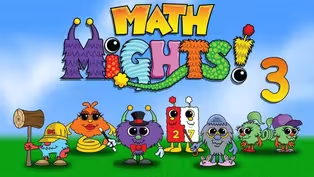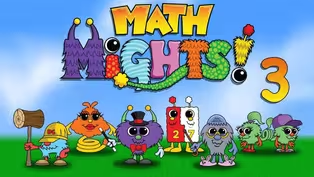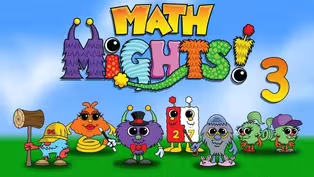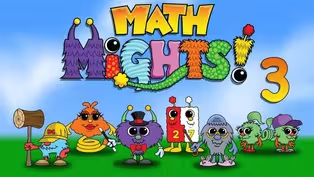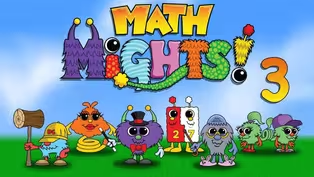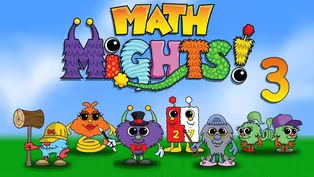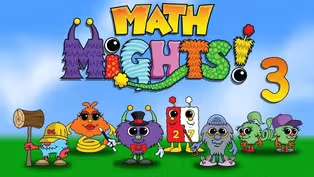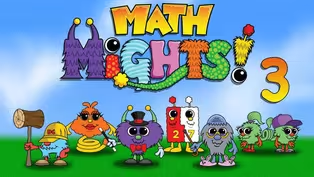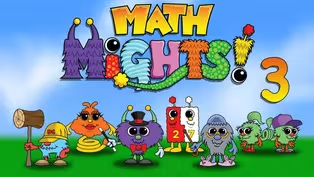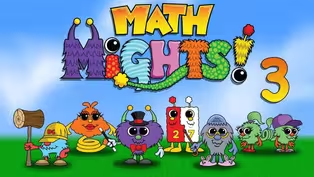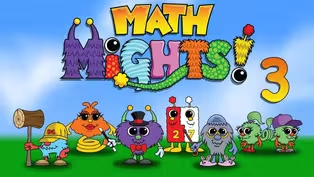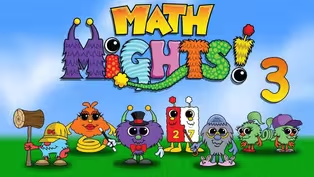Math Mights
Describe Parts of Fractions
Season 3 Episode 308 | 16mVideo has Closed Captions
Join Ms. Askew for a division word problem with her friend Professor Barble.
Join Ms. Askew for a division word problem with her friend Professor Barble. Next, to see if you use fraction language to describe fraction (partition, equal parts halves, thirds). Then we are going to create fraction strips together so you have a tool to use while learning fractions!
Problems playing video? | Closed Captioning Feedback
Problems playing video? | Closed Captioning Feedback
Math Mights is a local public television program presented by Detroit PBS
Math Mights
Describe Parts of Fractions
Season 3 Episode 308 | 16mVideo has Closed Captions
Join Ms. Askew for a division word problem with her friend Professor Barble. Next, to see if you use fraction language to describe fraction (partition, equal parts halves, thirds). Then we are going to create fraction strips together so you have a tool to use while learning fractions!
Problems playing video? | Closed Captioning Feedback
How to Watch Math Mights
Math Mights is available to stream on pbs.org and the free PBS App, available on iPhone, Apple TV, Android TV, Android smartphones, Amazon Fire TV, Amazon Fire Tablet, Roku, Samsung Smart TV, and Vizio.
Providing Support for PBS.org
Learn Moreabout PBS online sponsorshipMore from This Collection
Video has Closed Captions
Join Ms. Askew for a tricky multi-step word problem with Professor Barble! (15m 59s)
Build Fraction from Unit Fractions
Video has Closed Captions
Join Ms. Askew for another multi-step word problem with Professor Barble! (15m 59s)
Video has Closed Captions
Join Ms. Askew for a division word problem with her friend Professor Barble. (15m 59s)
Video has Closed Captions
Join Ms. Askew and Professor Barble to do a visual model with a word problem. (15m 59s)
Dividing with even larger numbers
Video has Closed Captions
Join Ms. Askew and Professor Barble to do a visual model with multiplication. (15m 59s)
Video has Closed Captions
Join Ms. Askew and Professor Barble to see if you can match visual models to word problems (15m 59s)
Dividing with Larger Quotients
Video has Closed Captions
Join Ms. Askew and Professor Barble to see if you can match visual models to word problems (15m 59s)
Video has Closed Captions
Learn about multiplying one-digit whole numbers by multiples of 10. (15m 59s)
Video has Closed Captions
Learn about multiplying numbers larger than 20. (16m)
Video has Closed Captions
Join Mrs. Askew for a Number Talk with 2 Math Might Friends! (16m)
Multiply Teen Numbers with Larger Groups
Video has Closed Captions
Join Mrs. Askew for a Number talk with 2 Math Might Friends! (15m 59s)
Relating Multiplication and Division
Video has Closed Captions
Join Ms. Askew for a subtraction number talk with Springling! (16m)
Providing Support for PBS.org
Learn Moreabout PBS online sponsorship(playful music) - [Children] Math Mights!
- Welcome, third grade Math Mights.
My name is Ms. Askew, and I'm so happy you decided to join us today.
Are you ready to have fun with math?
I sure am, so let's check out our plan for today.
Today, we're gonna do a word problem with our friend, Professor Barble.
After our word problem, we're going to describe parts of fractions.
Before we begin, let's warm up our math brains with Professor Barble as we conquer word problems using visual models.
Now, you might be asking yourself, what is a visual model?
Well, a visual model is sometimes known as a model drawing, unit bar, tape diagram, or bar model.
A visual model is a reading comprehension strategy for word problems.
Drawing a visual model helps to visualize the strategies and understand what the word problem is asking.
I think we need to call on our friend, Professor Barble, to help us with today's problem.
(adventurous music) Now, Professor Barble is a Math Might that travels and hikes all throughout Mathville.
He's looking for word problems to solve, On his travels, he's noticed that, oftentimes, we want to rush right into solving the problem without even thinking about what the question is asking.
So Professor Barble is teaching us to slow down and use a step-by-step process to help us work through what the problem is asking, so we don't have to guess.
When he's solving those word problems, he puts on his thinking cap so that he can create a visual model for that problem.
Let's look at what our problem is for today.
24 people are lined up to go in canoes.
Each canoe will have three people in it.
How many canoes will they need?
Kimmy thinks, in order to solve the problem, we should multiply.
Noah thinks, wait, should we divide?
Now, third grade Math Mights, if Professor Barble heard us talking, he would say we are jumping right into solving the problem, and that's step six.
We need to slow down and follow the step-by-step process so we can figure out what the problem is asking.
That way, we don't have to guess.
Let's begin with our first step and read the entire problem.
As we read the problem, we are going to put the important parts of the story problem into chunks to help us better understand what it is we're looking for.
24 people are lined up to go in canoes.
That's important.
Each canoe will have three people in it.
Also important information.
Now, the question is, how many canoes will they need?
Now that we've chunked our problem, let's look at step two.
We need to rewrite the question in sentence form with a blank space for the answer.
They will need blank canoes.
Professor Barble, we need your help.
We need your starting line so that we can create our visual model.
Step three, we need to determine who or what is involved in the problem.
We know that the who are the people and the what are the canoes.
In step four, we need to draw our unit bar, and I've done that already.
Now, step five is the most difficult part for third graders.
We're gonna go through that step very slowly.
We need to go back to the chunks and check when each part is added into the adjusted unit bars, and put in a question mark.
24 people are lined up to go in canoes.
So, on our unit bar, we're going to label 24 people, because they represent who are going to be in the canoes.
Let's go back and put a check for that chunk.
Each canoe will have three people in it.
We know that there are 24 people in line to go in the canoes.
We know that each canoe will have three people, but I don't know how many canoes they will need, but I for sure know that three people will be in each canoe.
Let's go back and check that chunk off in our story problem.
Now, the question is, how many canoes will they need?
I'm going to put my question mark here, because I need to determine how many canoes they will need.
Let's go back and check off that question in our problem.
In step six, we are going to correctly compute and solve the problem.
It looks like Kimmy understands, by looking at our visual model, that we need to divide and not multiply.
We are gonna take the 24 total people and divide them by three people in each canoe.
24 divided by three.
How can I figure that out?
If I think about multiplication, I know that three groups of of eight equals 24.
So, that must mean 24 divided by three equals eight.
And finally, in step seven, we need to write the answer in the sentence and make sure the answer makes sense.
They need eight canoes.
Excellent job, third grade Math Mights.
You worked really hard using Professor Barble's step-by-step strategy to slow yourself down so that you can understand what the problem is asking.
Let's check out our, ICAN statement for today.
I can use fractions to describe parts.
Take a look at these four pictures.
I want you to decide which one doesn't belong.
I wonder if you came up with a reason why one of those doesn't belong.
Let's take a look and see what Kimmy and Noah thinks.
Noah says A doesn't belong, because it is the only one that isn't split into rectangles, and if we look at picture A, it is kind of jagged and it doesn't make rectangles, so he's correct.
If we look at the other ones, they are split into rectangles.
Kimmy says B doesn't belong, because it is the only one with thirds, and if we look at the other pictures, she's correct.
They have been partitioned into two parts.
Noah says C doesn't belong, because it is the only one that doesn't have equal parts, and he's correct.
If we look at the other pictures, they are split or partitioned into equal parts.
Kimmy says D doesn't belong, because it is the only one with just a horizontal partition.
Horizontal means going across.
B is vertical, C is vertical, and A uses a jagged line.
What numbers could we use to label the shaded parts?
Noah says A and D could be labeled 1/2, because there are two parts that are equal and one is shaded.
If we look at A, we have one, two parts, and one of those parts has been shaded.
It's the same for letter D. Kimmy says B could be labeled as 1/3, because there are three parts and one is shaded.
One, two, three parts, and one has been shaded.
Can we label C?
Noah says you can't label C, because the shaded parts are not equal, and we know that when we label fractions, we have to have equal parts.
In picture C, one part is small and the other part is big, so those are not equal parts.
We came up with lots of reasons why each of these do not belong, but if we were to look back at those pictures and figure out which one doesn't belong because of equal or non equal parts, we would choose letter C, because letter C is the only picture that does not have equal parts.
Excellent job, Math Mights, using fraction language to describe those four pictures.
Now, we're going to create a tool that's going to help us more with fractions.
That tool is called fraction strips.
We're going to use our fraction strips to create one half.
We're gonna start with our white fraction strip, and we're gonna label that as one whole.
Then we're gonna take our green fraction strip and we're gonna create halves.
We're gonna take that strip and we're gonna partition it into two parts.
Now, we're gonna label each part.
Because we have two parts, the denominator is two.
This one part out of the two is called 1/2.
This part is also 1/2.
We can see that if we have 1/2 and another 1/2, it makes one whole, or it's equal to one whole.
If I have 1/2, how can I easily make 1/4?
Let's take a closer look and model that.
I'm gonna take the orange strip and I'm going to fold it in half one time.
This is going to give me two equal parts.
If I take that same strip and fold it in half again, that's going to give me four equal parts.
If I wanted to label that, I could say one part out of the four would be 1/4, and because we have four parts, that has to be our denominator.
Four total parts.
Looking at our fraction strips, we can see that, when we folded the first strip in half, it equaled one whole.
We can also see that our fourths also equal one whole.
Now, let's take a fraction strip and partition it into eighths.
I wonder how we can do that.
We're gonna take our blue fraction strip, and we're gonna partition it into eight parts.
We're gonna first fold it in half to make halves, then we're gonna fold it again, so that we have fourths, and then we're gonna fold it one more time, so that we have eight equal parts.
If I were to label this, I would say this one part out of the total eight parts is 1/8.
Looking at this fraction strip that's been divided into eighths, I can compare it to my one whole.
As you can see, it is equal to one whole.
Now, we're gonna use our fraction strip to create thirds.
I'm gonna take my strip and partition it into three equal parts.
As you can see, the whole has been partitioned into three equal parts.
If I look at one part out of the three, I can label that fraction as 1/3.
Do you see, third grade Math Mights, how even though we started with one whole strip, we divided it or partitioned it into three parts, but it still is the same or equal to one whole.
If I have 1/3, how can I easily make 1/6?
Let's use our fraction strip and create sixths.
I'm going to take my strip and partition it into first thirds, and can you take a guess, third grade Math Mights?
What do you think we are going to do next?
We're gonna take those thirds and fold it in half one more time.
As you can see, we have created six equal parts.
When we label those six equal parts, we would say one out of those six parts, and that fraction is called 1/6.
When we compare our six equal parts to our whole fraction, we notice that it is still the same.
Excellent job, third grade Math Mights, creating your fraction strips tools.
As you can see, we have all of our strips that we created today.
We started with one whole, and then we partitioned two equal parts to make halves, three equal parts to make thirds, four equal parts to make fourths, six equal parts to make sixths, and eight equal parts to make eighths.
Using the fraction strips is a great tool to help you when learning about fractions.
Let's take what we've learned so far and play a game called Guess That Fraction.
I'm gonna start with a whole fraction strip.
Then I'm going to take a part and lay it on that strip.
Can you guess what part that fraction is?
When you saw that fraction strip on the whole, was it kind of tricky for you to figure out what that fraction might be?
Maybe if I moved it, it would make it a little bit easier for you.
I'm gonna position this fraction strip in a different way.
Does that make it easier for you?
Can you visualize how many fractions strips we need to completely cover that whole?
If you guessed three parts, you're correct.
That fraction is 1/3, and we take three parts to cover the whole.
Wasn't that fun, third grade Math Mights?
You took your knowledge of fractions, and you were able to play a guessing game called Guess That Fraction.
Now it's time for you to make your own set of fraction strips.
Keep them in an envelope for safekeeping, so you can easily pull them out whenever you're working with fractions.
We had so much fun learning about fractions today, and I hope to see you again soon.
(playful music) (cheerful whistling) - [Child] Sis4teachers.org.
- [Child] Changing the way you think about math.
- [Announcer] This program is made possible with funding from the Michigan Department of Education, Governor's Education Emergency Funds, the state of Michigan, and by viewers like you.


- Home and How To

Hit the road in a classic car for a tour through Great Britain with two antiques experts.










Careers that Work

Support for PBS provided by:
Math Mights is a local public television program presented by Detroit PBS
